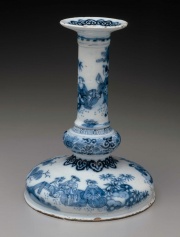Cobalt pigments
Description
Cobalt pigments are very stable, inert, unaffected by most chemicals and are not light sensitive. The most common cobalt pigment, Cobalt blue, is a cobalt aluminate and it was discovered in 1802. Cerulean blue is also a cobalt pigment (cobalt stannate). Cobaltic oxide is a black powder, cobalt black, that was used since the 8th century to give a brilliant blue color glaze and enamel. Cobalt green(cobalt oxide with some zinc oxide), [[cobalt_violet|cobalt violet] (cobalt phosphate or cobalt arsenate) and Cobalt yellow (potassium cobalt nitrite) were discovered by the mid-nineteenth century. Smalt, the earliest cobalt containing pigment, is actually glass which is colored with cobalt oxide and reduced to a powder.
Synonyms and Related Terms
pigmentos de cobalto (Esp., Port.); pigments de cobalt (Fr.); pigmenti al cobalto (It.)
Examples include: cobalt blue; Thenard's blue; Leithner blue; kings blue; zaffre; smalt; cobalt green; Rinman's green; zinc green; cobalt violet; cobalt red; cobalt yellow; aureolin; Dumont's blue; royal blue; cerulean blue; cobalt black;
Risks
- In general, cobalt pigments are moderately toxic.
- Skin contact may cause allergies, especially on elbows, neck and ankles.
- Chronic inhalation may cause asthma.
- Ingestion may cause vomiting, diarrhea and sensation of hotness.
Resources and Citations
- R. J. Gettens, G.L. Stout, Painting Materials, A Short Encyclopaedia, Dover Publications, New York, 1966
- Ralph Mayer, A Dictionary of Art Terms and Techniques, Harper and Row Publishers, New York, 1969 (also 1945 printing)
- Michael McCann, Artist Beware, Watson-Guptill Publications, New York City, 1979
